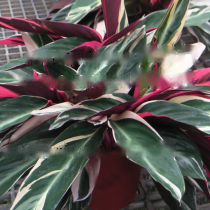
Chinese name: Three-color arrowroot
Latin name: Ctenanthe oppenhei miana'Quadricdor'
Alternative name: Yanjin dense flower arrowroot
Family: Arrowroot Genus: Arrowroot
1. Morphological characteristics of three-color Arrowroot
The whole plant of three-color Arrowroot is relatively Dwarf, with rhizomes, about 30 cm to 80 cm high, clustered with roots and leaves, oblong-lanceolate or narrowly oval, slightly thinner and flatter leaves, dark green leaf surface, with pale green, white to pale Pink pinnate spots, acuminate or protruding at the top, slightly narrow at the base, entire margin without serrations, petiole and leaf back dark red, petiole more slender cylindrical, leaf midrib obvious, inflorescence cymose terminal or axillary, The bracts are oblong-lanceolate, inwardly arched on both sides, the flowers are oval or kidney-shaped, and the flowers are mostly string-like and red.
2. Habits of the three-color arrowroot
The three-color arrowroot can adapt to the full-sun or half-sun growth environment. Growth is blocked or stopped in low temperature environment, not resistant to frost, plants are prone to frost damage, likes high temperature and high humidity, high temperature in summer leaves is not easy to lose water, tolerates half shade, but does not like too shaded state, avoid water accumulation, water accumulation affects root ventilation It can lead to poor growth or rotten roots. The soil requirements are not strict. Loose, fertile, well-drained humus soil or sandy loam soil is preferred, which is resistant to drought.
3. The three-color arrowroot is being cultivated
The three-color arrowroot can be cultivated by ramets and cuttings. The ramets are suitable to be carried out after the temperature warms up in spring. -It can be divided into pots once every 2 years. Divide the clump plants into several clumps along the growth direction of the underground rhizomes, and then plant them in pots and place them in a relatively shaded place for maintenance. After the roots develop, they can enter normal management. The cuttings are selected from the long knotted stems and leaves. Cuttings can be cut from the upper internodes of the mother plant during the mildew and rain season, inserted in humus or peat, and placed in a semi-shade environment after inserting.
Guess you like it
Oxtail | Triangulaceae | Mustard greens | Coral vegetables | Water mint | |Five awns|
Small pandanus| Small cattail| |
Large-flowered wheat bottle grass| Tiger's Eye Evergreen | tassel Fritillaria | Xinjiang Asafoetida |
![[Dog Training 5] The training method of pet dog dining etiquette](/static/img/12192/12192_1.jpg)




